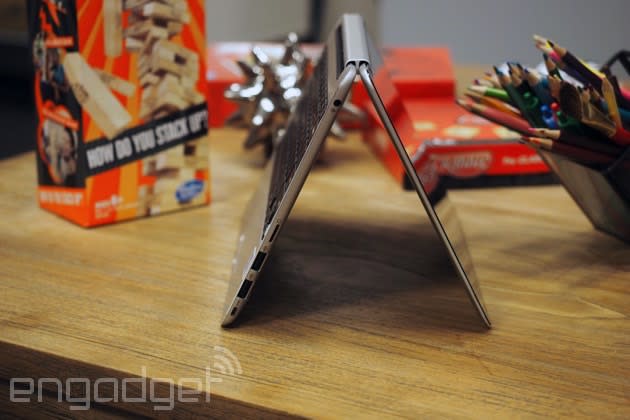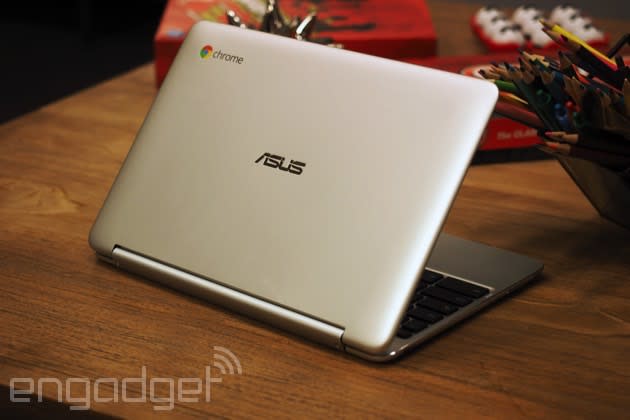ASUS Chromebook Flip review: small, solidly built, well-priced

I'm sick of reviewing Chromebooks. What was once the source of fierce debates about the future of computing is now a commodity: Most models have the same specs, the same internals and more or less perform the same. There are a lot of them, and most aren't particularly good or particularly bad. They're forgettable; unremarkable. That cranky preamble aside, I did want to test the Chromebook Flip. This machine, made by ASUS, is notable on a few counts. With a 10-inch screen, it's one of the smallest around, even if it does hearken back to the days of the netbook. It's one of the few with a 360-degree rotating touchscreen. The build quality is better than most, thanks to an all-metal chassis. The battery life is longer too, at 10.5 hours. Lastly, it's cheap for what it is: just $249. Yes, there's a catch -- several, even -- but all told, I recommend it anyway.
Hardware

I'm hardly the first person to compare Chromebooks to netbooks, but in this case, the comparison is apt: The Flip has a 10-inch screen and weighs less than two pounds, the same size as many of the first mini notebooks. The keyboard, too, is a throwback to ASUS' Eee PC series, with small, island-style buttons, some of them not much bigger than a fingernail. In absolute terms, it's not as comfortable to type on as the sort of keyboard you'd find on a larger machine. All things considered, though, the buttons feel generously spaced, considering the deck itself measures just 10.6 inches wide. None of the buttons are too small either -- Enter, Shift and Backspace are all plenty big -- and the underlying panel stands up well to vigorous typing. As it happens, I wrote much of this review on the Flip, not to mention: surfed the web and answered who-knows-how-many emails. Like I said, I don't think I'll ever prefer a 10-inch keyboard over, say, a 13-incher, but this one is at least decent. And if there's anyone who can make a miniature keyboard people might actually want to use, it's netbook granddaddy ASUS.
If there's one way in which the Flip is different from netbooks of yore, it's build quality. Forget the fact that netbooks never used to have 360-degree hinges like this, much less touchscreens -- or that this form factor is still uncommon on modern-day Chromebooks. This thing is also more solidly built than I'd ever expect from a $249 machine. The machine is all metal, with subtle brushed detailing on the palm rest that both looks nice and helps mask smudges. I've also noticed that when I pick up the laptop in one hand -- which I do often, since it's so light -- I don't feel any flex in the palm rest where I'm gripping it.

The one exception to this durability seems to be the screen, which tends to wobble a bit. You might not notice it so much in everyday use, but I got a big taste of it when I used the Flip on a bumpy Amtrak trip; every time the train jostled, so did the panel. Speaking of the display, you sort of get what you pay for here. The 1,280 x 800 resolution isn't as high as many standalone tablets at this size (many of which are more expensive anyway), and the bezels are unusually thick for a touchscreen. That said, colors are accurate and although the screen washes out when you dip it forward, the IPS panel did a good job minimizing glare when I used it next to an open window on my recent train ride.
Still, the hinge is sturdy enough that I felt confident flipping the screen back into tablet mode or -- more likely -- Tent and Stand modes. I say "more likely" because Chrome OS was primarily designed to be used with a mouse and keyboard -- precisely why we've yet to see any proper tablets running the software. I personally didn't have much use for it as a makeshift slate (although the screen size was about right). I do like having the option of putting the keyboard under and watching Netflix with the screen in front of me -- a particularly handy feature in confined spaces like a cramped coach seat. Let's be real, though: I mainly used this in classic notebook mode, and I didn't even have to use the touchscreen much, just because the touchpad was already precise. Don't get me wrong, I'm glad that the convertible form factor also happens to come with solid build quality, but I probably would have been just as happy to have a standard clamshell without a touchscreen.
Finishing our tour of the hardware, the Flip is well-stocked with ports, most of which are stacked along the right-hand side. These include two full-sized USB connections, a micro-HDMI socket, a microSD slot, a headphone jack and, on the other side, a volume rocker and power port.
Performance and battery life
SunSpider v.1.0.2* | Google Octane | Mozilla Kraken* | |
|---|---|---|---|
ASUS Chromebook Flip | 700ms | 6,748 | 5,527ms |
Chromebook Pixel (2015, Core i5, Intel HD 5500) | 298ms | 23,907 | 1,428ms |
Toshiba Chromebook 2 (Celeron N2840, 4GB RAM) | 967ms | 7,714 | 4,284ms |
Samsung Chromebook 2 (11-inch, Celeron N2840, 2GB RAM) | 525ms | 7,223 | 3,936ms |
Acer Chromebook 13 (NVIDIA Tegra K1, 2GB RAM) | 609ms | 7,051 | 4,816ms |
Lenovo N20p (Celeron N2830, 2GB RAM) | 567ms | 7,288 | 4,287ms |
ASUS C200 Chromebook (Celeron N2830, 2GB RAM) | 483ms | 7,198 | 4,291ms |
Acer C720 Chromebook (Celeron 2955U, 2GB RAM) | 342ms | 11,502 | 2,614ms |
Dell Chromebook 11 (Celeron 2955U, 4GB RAM) | 340ms | 11,533 | 2,622ms |
*SunSpider and Kraken: Lower scores are better. | |||
Let's recap: So far, we have a machine with mostly good build quality, a mediocre display and a low price. ASUS had to cut corners somewhere to make it all work, and it would appear that "somewhere" was performance. The Flip runs a quad-core Rockchip processor -- a presumably cheaper option than the Intel Atom or NVIDIA Tegra chips that power most other Chromebooks. Though the base $249 model has 2GB of RAM, we recommend you pony up an extra $30 to get the 4GB edition, which is the one I tested. Even then, it's still slower than other Chromebooks (not that any of them are really fast). In benchmarks, it trails machines like the Toshiba Chromebook 2 that have a newish Intel Celeron N2840 CPU, though its SunSpider JavaScript scores aren't the worst we've seen. In everyday use, I was easily able to juggle 10 tabs at a time, but with the lack of screen real estate I often didn't even want to push it that far.
Startup is pretty quick: about nine seconds to the login screen. The only odd thing there is that much of that time is actually eaten up by a long pause before you even see the "ASUS" splash screen. By the time you see the company's logo flash before you, you're actually almost done booting up.
As I said in my recent review of Google's second-gen Chromebook Pixel, Chrome has become more usable as an OS, partly thanks to a steady stream of improvements to the software itself, and partly because more and more services are now available in the browser (think: Skype, Spotify, Photoshop and popular messaging apps like Slack). As for Chrome, Google has steadily expanded the list of things you can do offline, so that you no longer need an internet connection for Gmail, Google Calendar, Drive, Google Play Music or Google Play Movies & TV. Many third-party web apps such as Pocket and Amazon Kindle Cloud Reader are now offline-capable, and there's even a section of the Chrome Web Store set aside for apps that don't need an internet connection. As I always say, the Chromebook setup will never be for everyone; there will always be people who need a proper Windows PC or Mac to install apps like Steam or iTunes. But personally, I've found I can survive on Chrome alone much better than I could even a few years ago, and I'm sure many mainstream users would agree.
Battery life | |
|---|---|
ASUS Chromebook Flip | 10:49 |
MacBook Air (13-inch, 2013) | 12:51 |
HP Spectre x360 | 11:34 |
Apple MacBook Pro with Retina display (13-inch, 2015) | 11:23 |
ASUS C200 | 11:19 |
Acer Chromebook 13 | 10:07 |
Chromebook Pixel (2015) | 10:01 |
Microsoft Surface 3 | 9:11 |
Samsung ATIV Book 9 Plus | 8:44 |
Samsung Chromebook 2 (13-inch) | 8:22 |
Apple MacBook (2015) | 7:47 |
Dell XPS 13 (2015) | 7:36 |
Lenovo Yoga 3 Pro | 7:36 |
Acer Aspire S7-392 | 7:33 |
Lenovo LaVie Z | 7:32 |
Microsoft Surface Pro 3 | 7:08 |
Lenovo LaVie Z 360 | 6:54 |
Toshiba Chromebook 2 | 6:34 |
Acer C720 Chromebook | 6:27 (Core i3) / 5:57 (Celeron) |
ASUS Transformer Book T300 Chi | 5:51 (Quad HD)/6:14 (Full HD) |
The Flip is rated for nine hours of battery life, which I'd say is actually conservative estimate. In Engadget's standard rundown test, which involves looping a full HD video at a fixed screen brightness, the machine lasted 10 hours and 49 minutes. In other words, it outlasted me in what was already a very long workday. With a more conservative screen setting and more intermittent use, I'm sure you could do even better. Even so, that nearly 11-hour showing is better than most Chromebooks we've seen, even battery life champs like the Acer Chromebook 13 and Google's latest "Pixel." Other than those two outliers, there's otherwise a steep drop-off between the Flip and other Chromebooks, with some models struggling to even break seven hours. Basically, then, the Flip might be underpowered compared to the competition, but it makes up for it with outstanding endurance.
Wrap-up

As I said from the outset, you'll be hard-pressed to find another Chromebook with this kind of convertible design. Lenovo had the similar N20p, for example, but it got lukewarm reviews and is no longer available on the company's site. That leaves a couple worthy competitors, none of them with a 360-degree hinge. Some favorites include the larger Acer Chromebook 13 ($350), which offers long battery life, a 1080p screen and a more spacious keyboard. We also like the 13-inch Toshiba Chromebook 2 (now $230), which has a low-glare IPS display (also full HD), along with fast WiFi and decent audio. Those models have more robust NVIDIA and Intel processors, respectively, allowing for slightly better performance than the Flip.
That said, the Chromebook Flip comes out to be nearly as good a choice, thanks to its versatile and extra-lightweight design, long battery life and surprisingly good build quality. Even if you rarely use the touchscreen, those attributes make it worth a close look. As a warning, its smaller-than-average keyboard might be a turnoff to some, but it's still usable, especially if you treat this as a secondary computer, perhaps a travel machine to use on the go. That shortcoming aside, the Flip is still a good deal even if you spring for the pricier $279 model.





















